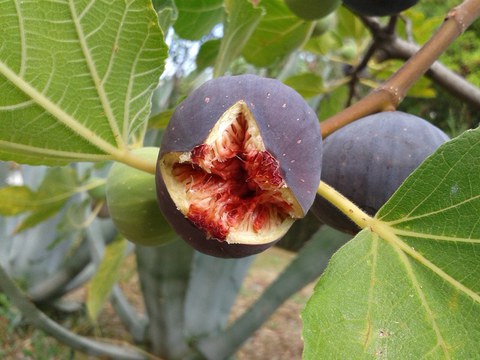15.06.2024
Tierisch Reich: Feigenwespen in der türkischen Wirtschaft

Feigenwespen sind die wichtigsten Bestäuber der klassischen Feigensorten in der Türkei. Die Türkei ist der größte Feigenproduzent weltweit, damit spielen die Feigenwespen eine wichtige Rolle für die Wirtschaft des Landes.
Wenn es die Feigenwespe nicht gäbe, könnten wir die Frucht heute wahrscheinlich nicht in jedem Supermarkt kaufen. Wespen sind nämlich die einzigen Bestäuber des Feigenbaums 1. Obwohl sie nicht so aussehen, sind Feigen botanisch gesehen umgekehrte Blüten1. Um ihre Eier dort abzulegen, krabbelt die weibliche Feigenwespe ins Innere der Feige und bringt dabei den Pollen zur Blüte1. Die erwachsene Wespe stirbt nach Ablegen ihrer Eier im Inneren der Feige, während ihre Nachkommen nach dem Schlüpfen aus der Feige herauswachsen2. Damit können sich sowohl die Wespe als auch die Feige erfolgreich fortpflanzen. Mittlerweile sind aber nicht mehr alle Feigenbäume auf die Feigenwespe als Bestäuber angewiesen. Einige Feigensorten wurden mittlerweile so gezüchtet, dass sie sich selbst bestäuben. Damit sind sie unabhängig vom Vorkommen der Feigenwespe und für die kommerzielle Feigenproduktion besser geeignet. Feigenwespen können außerdem Krankheiten übertragen, die den Feigenbaum schädigen und zu Ertragseinbußen führen1. Mit der Selbstbestäubung kann das Risiko zur Ausbreitung von Krankheiten vermindert werden. Dies wirft die Frage auf, inwiefern sich die wirtschaftliche Rolle der Feigenwespe seit der Einführung von selbstbestäubenden Pflanzen verändert hat.
Die Türkei ist der weltweit größte Feigenproduzent, etwa ein Drittel der weltweit produzierten Feigen stammen von dort3,4. Mit einem Anteil von rund 54 % am weltweiten Exportmarkt ist die Türkei auch der größte Exporteur getrockneter Feigen5. Viele ursprüngliche Feigensorten sowie Feigenwespen kommen innerhalb der Grenzen der Türkei natürlich vor1, 6. In Gebieten außerhalb des natürlichen Verbreitungsgebiets der Wespe ist die Befruchtung und der Anbau traditioneller Feigensorten teurer, da die Feigen in diesem Fall manuell bestäubt werden müssen1. Selbstbestäubende Feigen hingegen können auch Gebieten angebaut werden, in denen es keine Feigenwespen gibt und in denen die traditionellen Feigensorten nicht an die örtlichen Anbaubedingungen angepasst sind1. In vielen Fällen ist der Anbau selbstbestäubender Feigen also leichter zugänglich und wirtschaftlicher.
Aber welche Rolle spielen Feigenwespen und traditionelle Feigensorten noch in der Türkei?
Jedes Jahr werden in der Türkei rund 300.000 Tonnen Feigen produziert3,7. Im Jahr 2019 konnte damit ein Exportwert von 284.492 US-Dollar erzielt werden8. Rund 90 % der Feigenerzegnisse aus der Türkei sind aus traditionellen Feigensorten3, 6, also jene die auf die Feigenwespe als Bestäuber angewiesen sind. Ohne die Feigenwespe würde die türkische Feigenindustrie in ihrer heutigen Form also nicht existieren. Die Feigenindustrie bietet Arbeitsplätze für Landwirte, Verarbeiter, Exporteure und andere damit verbundene Branchen, wie Verpackung und Transport6. Gäbe es die Feigenwespe plötzlich nicht mehr, würde es in der Türkei zu einem Beschäftigungsrückgang und Einnahmeverlusten kommen.
Neben ihrer Bedeutung für die Wirtschaft spielt die Feigenwespe auch eine wichtige Rolle für die ökologische Gesundheit der traditionellen Feigenanbaugebiete. Feigenwespen fördern die Fremdbestäubung, übertragen also Pollen zwischen verschiedenen Pflanzen einer Art. Damit tragen sie zum Erhalt der genetischen Vielfalt der wilden und weniger kultivierten Feigensorten bei6. Das ist wichtig für deren evolutionäre Anpassungsfähigkeit an Krankheiten oder sich ändernde Lebensbedingungen. Durch Pestizide und schwindenden Lebensraum sind heutzutage viele Insektenpopulationen bedroht. Mit selbstbestäubenden Nutzpflanzen wird sichergestellt, dass Feigen auch bei abnehmenden Insektenpopulationen, produziert werden können. Dennoch bleibt es wichtig, die Insekten zu schützen, um ein gesundes Ökosystem aufrechtzuerhalten. Für wirtschaftliches Wachstum und gleichzeitigen Schutz der Arten, wäre also sinnvoll ein optimales Anbauverhältnis zwischen selbstbestäubenden und von Wespen bestäubten Sorten zu finden. Im Moment verlässt sich die türkische Feigenindustrie jedoch hauptsächlich auf die traditionellen Feigensorten und ihren Bestäuber, die Feigenwespe.
Paula Müller, Übersetzung Nele Kheim
Issue 21 (PDF)
